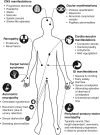"Red-flag" symptom clusters in transthyretin familial amyloid polyneuropathy
- PMID: 26663427
- PMCID: PMC4788142
- DOI: 10.1111/jns.12153
"Red-flag" symptom clusters in transthyretin familial amyloid polyneuropathy
Abstract
Transthyretin familial amyloid polyneuropathy (TTR-FAP) is a rare, progressive, life-threatening, hereditary disorder caused by mutations in the transthyretin gene and characterized by extracellular deposition of transthyretin-derived amyloid fibrils in peripheral and autonomic nerves, heart, and other organs. TTR-FAP is frequently diagnosed late because the disease is difficult to recognize due to phenotypic heterogeneity. Based on published literature and expert opinion, symptom clusters suggesting TTR-FAP are reviewed, and practical guidance to facilitate earlier diagnosis is provided. TTR-FAP should be suspected if progressive peripheral sensory-motor neuropathy is observed in combination with one or more of the following: family history of a neuropathy, autonomic dysfunction, cardiac hypertrophy, gastrointestinal problems, inexplicable weight loss, carpal tunnel syndrome, renal impairment, or ocular involvement. If TTR-FAP is suspected, transthyretin genotyping, confirmation of amyloid in tissue biopsy, large- and small-fiber assessment by nerve conduction studies and autonomic system evaluations, and cardiac testing should be performed.
Keywords: diagnosis; hereditary amyloidosis; transthyretin; transthyretin familial amyloid neuropathy.
© 2015 The Authors. Journal of the Peripheral Nervous System published by Wiley Periodicals, Inc. on behalf of Peripheral Nerve Society.
Figures
References
-
- Adams D, Théaudin M, Cauquil C, Algalarrondo V, Slama M (2014). FAP neuropathy and emerging treatments. Curr Neurol Neurosci Rep 14:435. - PubMed
-
- Andrade C (1952). A peculiar form of peripheral neuropathy: familiar atypical generalized amyloidosis with special involvement of the peripheral nerves. Brain 75:408–427. - PubMed
-
- Bergström J, Gustavsson A, Hellman U, Sletten K, Murphy CL, Weiss DT, Solomon A, Olofsson BO, Westermark P (2005). Amyloid deposits in transthyretin‐derived amyloidosis: cleaved transthyretin is associated with distinct amyloid morphology. J Pathol 206:224–232. - PubMed
-
- Briani C, Cavallaro T, Ferrari S, Taioli F, Calamelli S, Verga L, Adami F, Fabrizi GM (2012). Sporadic transthyretin amyloidosis with a novel TTR gene mutation misdiagnosed as primary amyloidosis. J Neurol 259:2226–2228. - PubMed
Publication types
MeSH terms
Supplementary concepts
LinkOut - more resources
Full Text Sources
Other Literature Sources
Research Materials
Miscellaneous



